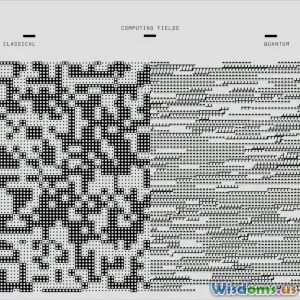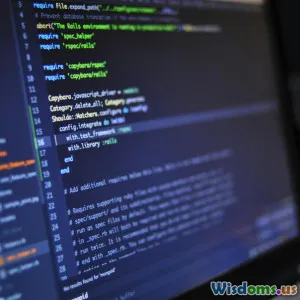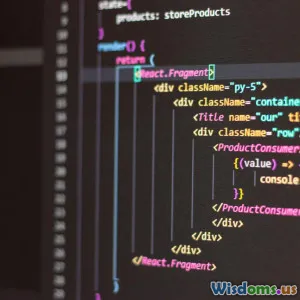
Future of Programming Languages
8 min read Explore how programming languages will evolve, transforming technology and shaping the future of software development. (0 Reviews)
The Future of Programming Languages: Navigating a New Era of Software Development
Programming languages have been the backbone of software innovation for decades. From the early days of Fortran and COBOL to the modern rise of Python and Rust, languages have continuously evolved to meet changing technological landscapes and developer needs. But what does the future hold? In an increasingly AI-driven, data-centric, and interconnected world, the evolution of programming languages promises to redefine how we create, maintain, and interact with software.
Introduction: Why the Future of Programming Languages Matters
Imagine a world where developers spend less time wrestling with complex syntax and debugging and more time unleashing creativity to solve real-world problems. With technology becoming more sophisticated—ranging from quantum computing to AI models—the languages we use must also transform.
Organizations invest billions annually into software. According to Evans Data Corporation, the global developer population is expected to surpass 40 million by 2024, escalating demand for efficient, intuitive programming tools. Whether you are a developer, project leader, or tech enthusiast, understanding future trends in programming languages is crucial to staying relevant and innovative.
1. Emergence of AI-Assisted and Natural Language Programming
One of the most profound shifts will be the integration of artificial intelligence (AI) in programming workflows. Tools like GitHub Copilot and OpenAI’s Codex demonstrate AI's ability to suggest code snippets, auto-complete tasks, and even generate functions based on human-like natural language input.
Developing a program might soon resemble having an expert pair programmer constantly assisting. Instead of memorizing API details or syntax quirks, developers will describe what they want in everyday language. This reduces the learning curve and accelerates prototyping.
Example:
- GitHub Copilot: Powered by OpenAI, Copilot can generate substantial blocks of code in many languages, such as Python and JavaScript, based on short comments or code fragments entered by the programmer.
Experts predict that in the next decade, natural language programming could let non-programmers contribute to software creation, blurring lines between users and developers. This democratization could spark novel innovation and inclusivity.
2. Growing Importance of Domain-Specific Languages (DSLs)
General-purpose languages (GPLs) like Java, C++, and Python have dominated for decades because of their broad applicability. However, highly specialized fields often need tailored languages that optimize productivity and correctness.
What Are DSLs?
Domain-Specific Languages are designed to solve problems in a particular domain with concise syntax and semantics. For example, SQL uniquely caters to database queries, while MATLAB focuses on numerical computing.
Expansion of DSLs:
With industries like finance, healthcare, and autonomous vehicles becoming more software-dependent, DSLs will gain ground. They facilitate faster development with fewer bugs and inherently embedded domain logic.
For instance, Kotlin’s rising use in Android development reflects how language design can align closely with platform-specific requirements.
3. Paradigm Shifts: Multilingual and Polyglot Programming
Software projects grow increasingly complex, often requiring several programming paradigms—from procedural and object-oriented to functional and reactive programming.
Polyglot Programming
We already observe polyglot environments where microservices written in different languages co-exist, each optimized for particular tasks. In the future, single projects might leverage multiple paradigms within a unified ecosystem.
Languages will need to better interoperate with others and support modular usage of paradigms. For example, Rust allows safe procedural code with functional programming features, aiding systems-level development with guaranteed safety.
4. Focus on Safety, Concurrency, and Performance
Modern challenges like distributed systems, edge computing, and real-time applications demand programming languages that prioritize safety, concurrency, and efficiency.
Memory safety bugs—such as those causing data races—have driven interest in languages like Rust, which enforces strong compile-time safety guarantees without sacrificing performance.
Data:
- A Stack Overflow developer survey in 2023 ranked Rust as the most loved language for its safety and high performance.
Languages that make concurrency straightforward and inherently safe—integrated with modern processors’ multi-core capabilities—will become essential tools.
5. Quantum Programming Languages on the Horizon
Although still emerging, quantum computing will necessitate new kinds of languages optimized for quantum bits (qubits) and quantum operations.
People are already experimenting with quantum programming languages like Q#, IBM's Qiskit (Python-based), and Google's Cirq.
While quantum computing is in infancy, research suggests future programming environments will integrate classical and quantum codebases. This hybridization will unlock unprecedented computational power for certain problem classes, from cryptography to optimization.
6. Sustainability and Energy-Efficient Coding
The environmental impact of technology is gaining attention, with software playing a role. Programming languages and tools will likely evolve to optimize energy usage of applications during runtime.
Emerging language designs might include energy profiling features, better concurrency models to minimize CPU idle times, and facilitation of green computing standards.
Conclusion: Prepare for an Adaptive Programming Landscape
The future of programming languages is vibrant and multifaceted. Advances driven by AI will streamline programming and open it to wider audiences through natural language interfaces.
Simultaneously, sectors will rely heavily on DSLs and polyglot ecosystems adapted to their unique challenges, while global concerns around safety, concurrency, performance, and sustainability shape design priorities.
For developers and organizations, embracing continuous learning and adaptability will be key. Early experimentation with AI-assisted tools and emerging languages like Rust or DSLs could provide competitive advantages.
Ultimately, programming languages will increasingly empower humans, not just machines—bridging creativity, domain knowledge, and technology in unprecedented ways. The future lies in melding intelligence, efficiency, and inclusivity to drive tomorrow’s innovation.
References:
- Evans Data Corporation, Developer Population Estimates, 2021-2024.
- Stack Overflow Developer Survey, 2023 Trends Report.
- "Programming in the Age of Artificial Intelligence," ACM Queue, 2022.
- Microsoft’s Q# Quantum Programming Documentation.
- "Rust: The Language Empowering Next-Gen Systems Developers," Mozilla Foundation Report, 2023.
Author’s Note: This article integrates insights from technology industry experts, developer surveys, and research institutions to present a grounded, forward-looking perspective on programming language evolution.
Rate the Post
User Reviews
Popular Posts

















